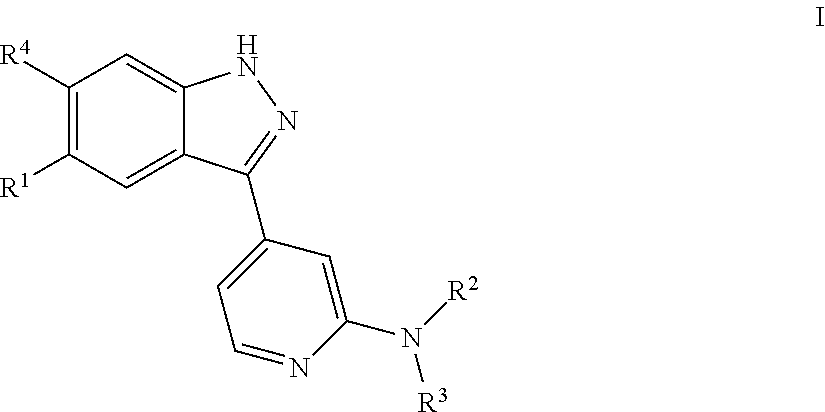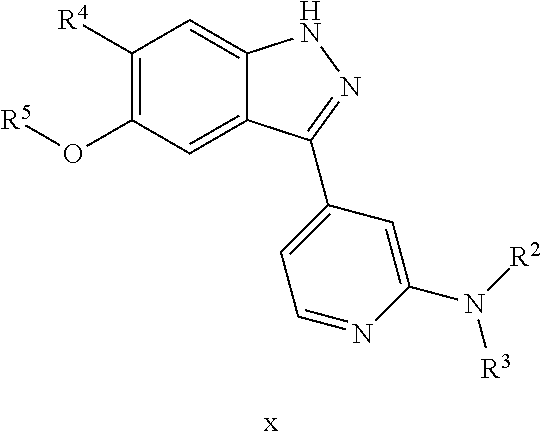Compounds inhibiting leucine-rich repeat kinase enzyme activity
- Summary
- Abstract
- Description
- Claims
- Application Information
AI Technical Summary
Benefits of technology
Problems solved by technology
Method used
Image
Examples
example 1
can be prepared by either Method A or Method B below.
Method A:
Step 4
[0218]
[0219]Combined 3-(2-fluoropyridin-4-yl)-1-{[2-(trimethylsilyl)ethoxy]methyl}-1H-indazole (0.30 g, 0.87 mmol) and morpholine (0.76 g, 8.73 mmol) at rt, either using morpholine as the solvent or in DMF with a few drops of triethylamine. The mixture was heated at 90° C. overnight. After cooling to rt, the mixture was diluted with EtOAc and washed with 10% aq. citric acid (brought to pH 5 with 1N NaOH), water, and brine. The organics were dried (Na2SO4), concentrated and purified by silica gel chromatography (gradient elution, 0-100% EtOAc / hexanes) to afford the title compound; LRMS (ESI) m / z 411.1 [(M+H)+ calcd for C22H31N4O2Si: 411].
Step 5
[0220]
[0221]Bubbled HCl (g) through a solution of 3-[2-(morpholin-4-yl)pyridin-4-yl]-1-{[2-(trimethylsilyl)ethoxy]methyl}-1H-indazole (50 mg, 0.12 mmol) in MeOH (1.2 mL) at 0° C. for 5 min. The resulting solution was heated at 60° C. in a sealed tube overnight. After cooling to...
example 98
sing conditions outlined in Scheme J using the appropriate pyridyl boronate ester. LCMS (ESI) m / z 358.0 (Ret.=0.75 min, LCMS condition a).
Step 1
[0266]
[0267]To a suspension of 5-bromo-3-[2-(morpholin-4-yl)pyridin-4-yl]-1-{[2-(trimethylsilyl) ethoxy]methyl}-1H-indazole (Step 3, Scheme D) (100 mg, 0.20 mmol), 2-(4,4,5,5-tetramethyl-1,3,2-dioxaborolan-2-yl)pyridine (84 mg, 0.41 mmol), and cesium carbonate (266 mg, 0.82 mmol) in DMF (1.9 mL) at rt under N2 were added copper(I) chloride (20.2 mg, 0.20 mmol), palladium(II) acetate (2.3 mg, 0.01 mmol), and 1,1′-bis(diphenylphosphino)ferrocene (11 mg, 0.020 mmol). The resulting mixture was heated at 100° C. in a sealed vessel for 16 h. After cooling to rt, the mixture was filtered through Celite, diluted with EtOAc, washed with water, dried (Na2SO4), and concentrated. Purification by silica gel chromatography (gradient elution, 0-100% EtOAc / hexanes) afforded the title compound; LRMS (ESI) m / z 488.0 [(M+H)+ calcd for C27H34N5O2Si: 488].
Step 2...
example 169
by mass triggered HPLC using the following conditions: [Waters Sunfire C18 column, 5 μm, 19×100 mm, gradient range 40-45% initial to 70% final MeCN (0.1% formic acid) in water (0.1% formic acid) 70 mL / min, 8 min run time].
LCMSLRRK2RTIC50ExStructureCond.(min)m / z(nM)141d0.97391.351.4142d0.91364.221.4143d1.02398.3113.3144d1.08374.329.2145d0.83428.352146d0.86440.336.8147d1.04417.370.8148d0.93442.323.9149d1.12367.379.6150d0.87355.351.7151d1.12401.351.9152d0.98351.335.8153d0.85365.329.7154d0.98339.339.4155d0.89392.413.4156d1.07365.353.1157d1.02393.334.4158d0.86415.430.9159d1.12443.4781.6160d1.17391.4140161d0.94393.332162d0.85405.427.2163d0.91422.434.9164d0.87381.327.7165d0.76394.423.4166d1.00387.373.5167d0.99443.478168d0.84397.433.4169d1.12409.3169.3
[0373]Parallel preparation of Examples 170-184: In a glove bag under an atmosphere of nitrogen to a set of vials was added bis(cyclooctadiene)nickel (0) (2.1 mg, 0.0075 mmol), 1,3-bis-(2,6-diisopropylphenyl)imidazolinium chloride (6.4 mg, 0.01...
PUM
| Property | Measurement | Unit |
|---|---|---|
| Pharmaceutically acceptable | aaaaa | aaaaa |
Abstract
Description
Claims
Application Information
 Login to View More
Login to View More - R&D Engineer
- R&D Manager
- IP Professional
- Industry Leading Data Capabilities
- Powerful AI technology
- Patent DNA Extraction
Browse by: Latest US Patents, China's latest patents, Technical Efficacy Thesaurus, Application Domain, Technology Topic, Popular Technical Reports.
© 2024 PatSnap. All rights reserved.Legal|Privacy policy|Modern Slavery Act Transparency Statement|Sitemap|About US| Contact US: help@patsnap.com










